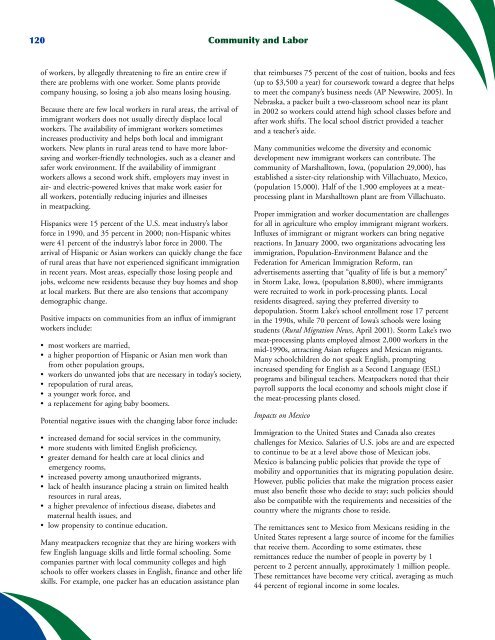The Future of Animal Agriculture in North America - Farm Foundation
The Future of Animal Agriculture in North America - Farm Foundation
The Future of Animal Agriculture in North America - Farm Foundation
You also want an ePaper? Increase the reach of your titles
YUMPU automatically turns print PDFs into web optimized ePapers that Google loves.
120<br />
<strong>of</strong> workers, by allegedly threaten<strong>in</strong>g to fire an entire crew if<br />
there are problems with one worker. Some plants provide<br />
company hous<strong>in</strong>g, so los<strong>in</strong>g a job also means los<strong>in</strong>g hous<strong>in</strong>g.<br />
Because there are few local workers <strong>in</strong> rural areas, the arrival <strong>of</strong><br />
immigrant workers does not usually directly displace local<br />
workers. <strong>The</strong> availability <strong>of</strong> immigrant workers sometimes<br />
<strong>in</strong>creases productivity and helps both local and immigrant<br />
workers. New plants <strong>in</strong> rural areas tend to have more laborsav<strong>in</strong>g<br />
and worker-friendly technologies, such as a cleaner and<br />
safer work environment. If the availability <strong>of</strong> immigrant<br />
workers allows a second work shift, employers may <strong>in</strong>vest <strong>in</strong><br />
air- and electric-powered knives that make work easier for<br />
all workers, potentially reduc<strong>in</strong>g <strong>in</strong>juries and illnesses<br />
<strong>in</strong> meatpack<strong>in</strong>g.<br />
Hispanics were 15 percent <strong>of</strong> the U.S. meat <strong>in</strong>dustry’s labor<br />
force <strong>in</strong> 1990, and 35 percent <strong>in</strong> 2000; non-Hispanic whites<br />
were 41 percent <strong>of</strong> the <strong>in</strong>dustry’s labor force <strong>in</strong> 2000. <strong>The</strong><br />
arrival <strong>of</strong> Hispanic or Asian workers can quickly change the face<br />
<strong>of</strong> rural areas that have not experienced significant immigration<br />
<strong>in</strong> recent years. Most areas, especially those los<strong>in</strong>g people and<br />
jobs, welcome new residents because they buy homes and shop<br />
at local markets. But there are also tensions that accompany<br />
demographic change.<br />
Positive impacts on communities from an <strong>in</strong>flux <strong>of</strong> immigrant<br />
workers <strong>in</strong>clude:<br />
• most workers are married,<br />
• a higher proportion <strong>of</strong> Hispanic or Asian men work than<br />
from other population groups,<br />
• workers do unwanted jobs that are necessary <strong>in</strong> today’s society,<br />
• repopulation <strong>of</strong> rural areas,<br />
• a younger work force, and<br />
• a replacement for ag<strong>in</strong>g baby boomers.<br />
Potential negative issues with the chang<strong>in</strong>g labor force <strong>in</strong>clude:<br />
• <strong>in</strong>creased demand for social services <strong>in</strong> the community,<br />
• more students with limited English pr<strong>of</strong>iciency,<br />
• greater demand for health care at local cl<strong>in</strong>ics and<br />
emergency rooms,<br />
• <strong>in</strong>creased poverty among unauthorized migrants,<br />
• lack <strong>of</strong> health <strong>in</strong>surance plac<strong>in</strong>g a stra<strong>in</strong> on limited health<br />
resources <strong>in</strong> rural areas,<br />
• a higher prevalence <strong>of</strong> <strong>in</strong>fectious disease, diabetes and<br />
maternal health issues, and<br />
• low propensity to cont<strong>in</strong>ue education.<br />
Many meatpackers recognize that they are hir<strong>in</strong>g workers with<br />
few English language skills and little formal school<strong>in</strong>g. Some<br />
companies partner with local community colleges and high<br />
schools to <strong>of</strong>fer workers classes <strong>in</strong> English, f<strong>in</strong>ance and other life<br />
skills. For example, one packer has an education assistance plan<br />
Community and Labor<br />
that reimburses 75 percent <strong>of</strong> the cost <strong>of</strong> tuition, books and fees<br />
(up to $3,500 a year) for coursework toward a degree that helps<br />
to meet the company’s bus<strong>in</strong>ess needs (AP Newswire, 2005). In<br />
Nebraska, a packer built a two-classroom school near its plant<br />
<strong>in</strong> 2002 so workers could attend high school classes before and<br />
after work shifts. <strong>The</strong> local school district provided a teacher<br />
and a teacher’s aide.<br />
Many communities welcome the diversity and economic<br />
development new immigrant workers can contribute. <strong>The</strong><br />
community <strong>of</strong> Marshalltown, Iowa, (population 29,000), has<br />
established a sister-city relationship with Villachuato, Mexico,<br />
(population 15,000). Half <strong>of</strong> the 1,900 employees at a meatprocess<strong>in</strong>g<br />
plant <strong>in</strong> Marshalltown plant are from Villachuato.<br />
Proper immigration and worker documentation are challenges<br />
for all <strong>in</strong> agriculture who employ immigrant migrant workers.<br />
Influxes <strong>of</strong> immigrant or migrant workers can br<strong>in</strong>g negative<br />
reactions. In January 2000, two organizations advocat<strong>in</strong>g less<br />
immigration, Population-Environment Balance and the<br />
Federation for <strong>America</strong>n Immigration Reform, ran<br />
advertisements assert<strong>in</strong>g that “quality <strong>of</strong> life is but a memory”<br />
<strong>in</strong> Storm Lake, Iowa, (population 8,800), where immigrants<br />
were recruited to work <strong>in</strong> pork-process<strong>in</strong>g plants. Local<br />
residents disagreed, say<strong>in</strong>g they preferred diversity to<br />
depopulation. Storm Lake’s school enrollment rose 17 percent<br />
<strong>in</strong> the 1990s, while 70 percent <strong>of</strong> Iowa’s schools were los<strong>in</strong>g<br />
students (Rural Migration News, April 2001). Storm Lake’s two<br />
meat-process<strong>in</strong>g plants employed almost 2,000 workers <strong>in</strong> the<br />
mid-1990s, attract<strong>in</strong>g Asian refugees and Mexican migrants.<br />
Many schoolchildren do not speak English, prompt<strong>in</strong>g<br />
<strong>in</strong>creased spend<strong>in</strong>g for English as a Second Language (ESL)<br />
programs and bil<strong>in</strong>gual teachers. Meatpackers noted that their<br />
payroll supports the local economy and schools might close if<br />
the meat-process<strong>in</strong>g plants closed.<br />
Impacts on Mexico<br />
Immigration to the United States and Canada also creates<br />
challenges for Mexico. Salaries <strong>of</strong> U.S. jobs are and are expected<br />
to cont<strong>in</strong>ue to be at a level above those <strong>of</strong> Mexican jobs.<br />
Mexico is balanc<strong>in</strong>g public policies that provide the type <strong>of</strong><br />
mobility and opportunities that its migrat<strong>in</strong>g population desire.<br />
However, public policies that make the migration process easier<br />
must also benefit those who decide to stay; such policies should<br />
also be compatible with the requirements and necessities <strong>of</strong> the<br />
country where the migrants chose to reside.<br />
<strong>The</strong> remittances sent to Mexico from Mexicans resid<strong>in</strong>g <strong>in</strong> the<br />
United States represent a large source <strong>of</strong> <strong>in</strong>come for the families<br />
that receive them. Accord<strong>in</strong>g to some estimates, these<br />
remittances reduce the number <strong>of</strong> people <strong>in</strong> poverty by 1<br />
percent to 2 percent annually, approximately 1 million people.<br />
<strong>The</strong>se remittances have become very critical, averag<strong>in</strong>g as much<br />
44 percent <strong>of</strong> regional <strong>in</strong>come <strong>in</strong> some locales.

















